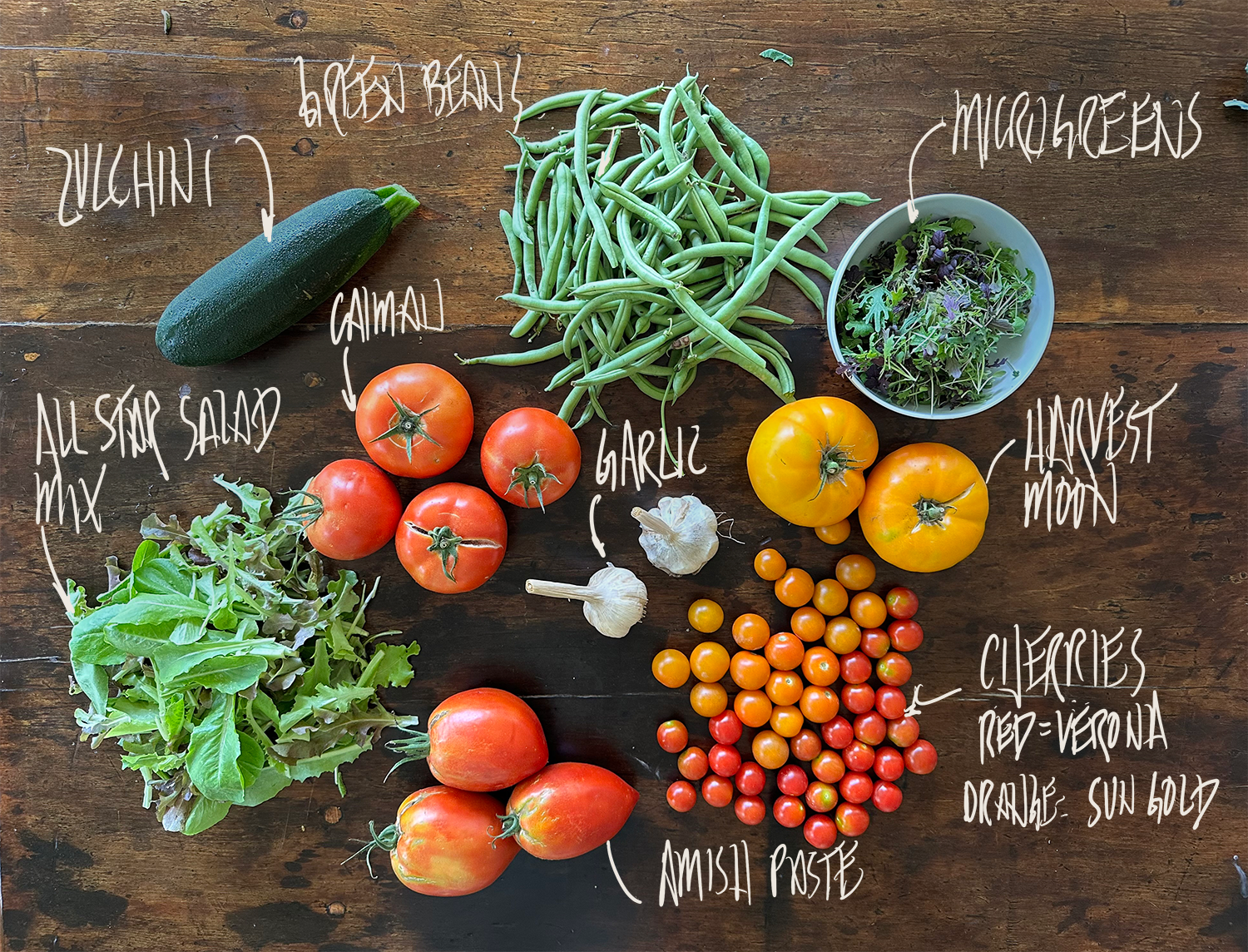2024 Summer | Week 8
If it's not one thing, it's another.
Organic farming is hard.
Water Woes.
One of the most critical aspects of farming is having access to clean, affordable water. And how you water each crop is an art form in itself. We are lucky to have a well, but the water has lots of iron. We learned - the hard way - that iron will clog all your waterlines and sprinkler heads and turn some veggies a rust color. (It is not a good look on a green bean!) We've invested heavily in having access to clean, potable water over the years, and it has been up and running for some time now. Until now, we've had some water issues for the last few weeks, so we've been reminded of how critical it is and how much time hand watering requires. Charlotte has taken on the responsibility while we try to work out some of the kinks in our rather complex system. Thanks to her, we've been able to keep things going.
Pests.
This is our first week of the 2024 season to offer zucchini - we were late getting it in, but our crop looks perfect so far. In past years we've been plagued with squash beetles that suck the life out of the plants. Insect netting goes a long way but can - in the case of zucchini - interrupt the pollination of the fruit.
Disease.
Every plant has something that can shorten the life of a crop. Basil has been difficult for us over the years. Many plants don't like to get their leaves wet - basil, squash, and tomatoes come to mind. Pathogens like downy mildew can take your crop out overnight, and there's little to remedy the situation.
So, for every successful crop we harvest, many others don't make it. Experience and luck are the keys, and we are slowly learning some hard lessons on our way to more consistent success. Have a good week.
Here’s what’s in your crates this week.
-
Here’s what Johnny’s says about this mix:A specially designed blend based on two years of trial research to make your salad mix stand out from the crowd. Selected varieties yield darker reds and greens even under low-light conditions. Ruffled edges and unique leaf shapes provide loft, interesting texture, good shelf life, and fancy appearance. Includes green oakleaf, red oakleaf, green romaine, red romaine, lollo rossa, and red leaf lettuces.
-
GREEN BEANS 101 - Turning a vibrant, beautiful green when cooked, string beans are versatile and delicious. Easy to prepare, string beans are great sautéed, roasted, grilled, or in stir-fry – we even like snacking on them while we cook! We believe simple is almost always better and like them best with a little of our 1808 Olive Oil, salt, and pepper. If you’re feeling spicy, try adding red pepper flakes.
EAT NOW - Rinse beans in cool water and pat dry. Snap off stem and any damaged parts before use. Can be eaten raw or cooked in a variety of delicious ways!
OR LATER - Store unwashed beans in a perforated plastic bag in the veggie bin of your fridge for up to 1 week. Rejuvenate limp beans by soaking them in ice water for 30 min. To freeze, blanch, dry well, and pack into airtight containers.
To blanch, bring a pot of lightly salted water to a rolling boil. While you wait for boil, prepare an ice bath. Once boiling, drop veggies into water - water should return to boil within a minute otherwise you have too much veg for the water. Once boil has returned, cook for 1-5 min until veg has a vibrant color. Immediately put into ice bath to stop cooking.
RECIPIES
-
Microgreens 101—Before use, rinse gently in cool (not hot or cold) water to remove excess dirt. Pat or spin dry, and you’re good to go! Pat or spin dry your greens to remove excess moisture (moisture = mush!). Place loosely in a plastic bag or container and put in the fridge. They will keep for up to one week.
Eat These Immediately!
-
PEPPERS 101 - Whether hot or sweet, peppers are full of beneficial vitamins and minerals and are great raw or cooked. They can be sliced on pizzas or as part of salads and even stuffed with meats and cheeses. Hotter peppers like jalapeños can be cooked or roasted to reduce their heat. They make a great addition to any meal such as: sandwiches, tacos, pizzas, or chopped and added to soups, stews, sauces and more. Our personal favorite, are Jalapeño Poppers.
EAT NOW - First rinse and dry your peppers. Cut off the top and slice. If preparing hot peppers, be careful to wash your hands after handling - don’t touch your eyes! For less spicy peppers, cut in half length-wise and remove seeds and ribs. Are best stored whole.
OR LATER - Store whole or sliced in fridge for up to 1 week. To store longer, flash freeze (whole or sliced) on a cookie sheet. Transfer to a freezer bag once frozen. They keep well in the freezer – no need to thaw for use in cooked dishes.
RECIPES
-
SQUASH 101 - Because of their bland flavor, summer squash lend themselves to many cooking applications, taking on the flavor of whatever they’re cooked with. Try using them as a substitute for rice, pasta or potatoes. Or, slice tender, young squash into salads, stir-fries, or with pasta. The are also great on the grill!
EAT NOW - Gently scrub away dirt. Slice off the tops. Can be roughly chopped, sliced, or grated for a variety of recipes from steamed to stuffed to stir-fried!
OR LATER - Store squash unwashed in a perforated plastic bag in the vegetable bin for about a week and a half. Freeze pureed (seeded) zucchini in Ziplock bags, and grated zucchini for use in breads and muffins.
RECIPE
-
TOMATOES 101 - Probably the most versatile fruit in the garden, tomatoes can be used in countless ways - salsa, gazpacho, sauces, slow roasted, puree and even a bloody Mary. Ours are grown for taste so eat them right out of the crate.
EAT NOW - Store unripe tomatoes upside down on a plate at room temperature until they fully ripen. Wash, pat dry, slice or dice, and enjoy the taste of a real tomato.
OR LATER - Refrigerate any fully ripe tomatoes - allow to come to room temp before serving. To freeze, first blanch and dunk in ice water to cool. Remove stems and core. Transfer to storage bags, seal and place in freezer.
To blanch, bring a pot of lightly salted water to a rolling boil. While you wait for boil, prepare an ice bath. Once boiling, drop veggies into water - water should return to boil within a minute otherwise you have too much veg for the water. Once boil has returned, cook for 1-5 min until veg has a vibrant color. Immediately put into ice bath to stop cooking.
RECIPES

